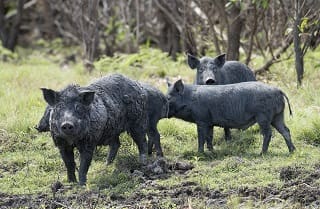THE CENTRE for Invasive Species Solutions has received some additional funding from the Federal Government to assist the National Pest Animal Management Coordination Program.
The increased funding will advance the activities of the Centre’s National Feral Cat and Fox Management Coordinator Program and the National Wild Dog Action Plan and supports the Centre’s drive to reduce the $25 billion annual cost of invasive species in Australia.
“This funding announcement highlights the Federal Government’s commitment to working alongside organisations such as ours to combat the devasting environmental, social and economic impacts of invasive species,” CISS chair Bruce Christie said.
“Although Australia is a leader in containing pests and weeds, there is always more we can and should be doing to prevent the spread of invasive species.
This funding increase will enhance the Centre’s capacity to guard our unique ecosystem against such threats”.
The centre employs national coordinators to support the management of feral cats, foxes and wild dogs as well as supporting externally based national coordinators for wild deer and feral pigs.
National feral cat and fox-management coordinator Gillian Basnett said she was looking forward to continuing to work with the Federal Government and other key stakeholders to enhance the national coordination of invasive species control.
“This ongoing funding for national coordination means we can build on work we have undertaken over the first two years of the project,” Ms Basnett said.
“We can better equip landholders and land managers in effective on-ground management programs, seek to decrease the number of native animals threatened by feral cats and foxes and reduce their agricultural impacts”.
“This is great news; it gives us the opportunity to deliver current activities and will better support our efforts over the coming two years.
“We still have a lot of work to do and need to keep the foot on the pedal, but this funding goes a long way in protecting our biodiversity system, our way of life, as well as enhancing productivity,”National Wild Dog Action Plan Coordination Committee chair Geoff Power said.
Pig problem big in NSW
This latest round of Federal Government funding does not target feral pig control, and NSW Farmers is calling for more resources to combat what it said was an exponential rise in the number of highly destructive populations of the dangerous and destructive animal.

Feral pig populations are booming in NSW. Photo: Southern New England Landcare
NSW Farmers president Xavier Martin said millions of feral pigs were breeding and rampaging across the countryside, thriving after years of high rainfall, attacking native animals and livestock, and causing massive damage to crops and infrastructure.
Mr Martin said the past three years had been a boom time for pigs, and while government control efforts had made a slight dent in the overall number of pigs in certain areas, there were too many reports of a booming breeding population to ignore.
“From the Western Riverina through the Central West and up into the Northern Tablelands, we’re hearing members tell us they’ve never seen pigs this bad before,” Mr Martin said.
“Aerial shooting over the past year saw 80 percent more pigs culled than the year before, and authorities have distributed 74 tonnes of baits to landholders, but the numbers continue to grow, particularly on public land.
“It’s clear the pig numbers are growing out of control now, and we need a drastic and sustained increase in resources for everyone involved to get on top of the problem once and for all.”
According to Local Land Services, more than 63,000 feral pigs had been culled as part of co-ordinated aerial and on-ground shooting and baiting in the past 12 months.
Mr Martin said anecdotal reports from farmers meant the actual numbers were likely far higher, and that serious concerns existed about what would happen after June 30, when the state government’s additional pig control funding ended.
“Trying to keep the pig numbers down farm-by-farm is a bit like trying to put out half a fire – if you’re not tackling the whole problem methodically, it’ll just keep coming back,” Mr Martin said.
“A lack of effective control on public lands is undermining our collective efforts, and we know that’s where the pigs are breeding because we see them coming onto our farms from public lands.
“We need more resources and a solid commitment from all parties involved to tackle feral pigs so we can get on top of them and stay on top of them.”
Source: Centre for Invasive Species Solutions, NSW Farmers

HAVE YOUR SAY